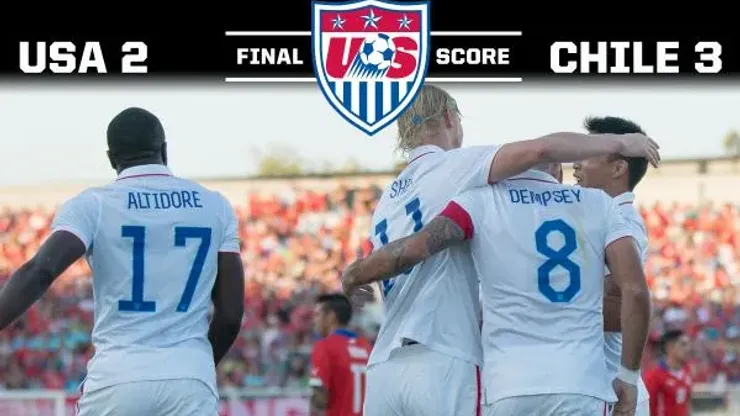Rumors had been spreading throughout January that Jurgen Klinsmann would implement a 3-5-2 formation when the US took on Chile in Rancagua. The lineup that was sent out Wednesday validated those rumors. Klinsmann has always been a fan of pushing players out of their comfort zones, whether it be positionally, tactically, or who they are playing. The game against Chile proved to be a game with all of those challenges. So how did they fare?
If the 3-5-2 is going to be used on a consistent basis, changes have to be made at the back to solidify the formation. Jermaine Jones may be a great leader and organizer at the back according to Klinsmann, but his positional discipline simply isn’t good enough to stay at home as a centerback, especially in a 3 man backline. On many occasions, there were simple mix-ups with Matt Besler as to who was marking who, which directly led to one goal and also to one that was incorrectly ruled as offside. In a 3-5-2, Jones will be better as a midfielder as opposed to a centerback where he will be allowed to roam a bit more and break up play ahead of the back 3. The formation works best with a true defensive midfielder, and that is where Jones will work best.
The wingbacks in this formation are the most important players on the pitch, not only because of the width they generate but because they are responsible for making sure the centerbacks do not get dragged out in wide areas in the attacking third. DeAndre Yedlin has the fitness to play as a wingback, and his speed is going to be incredibly difficult to deal with wherever he plays. Brek Shea is too unreliable defensively to play that formation, however his end product in the offensive third was very good, including a good finish on the first US goal. Shea may have earned himself more looks with that goal, but other than that, he was actually quite poor.
While the US was in the 3-5-2 formation, the midfield two of Mix Diskerud and Michael Bradley was interesting, especially when Jermaine Jones joined the midfield. They combined well together, and Mix showed a more physical side to his game, especially putting in tackles to start counterattacks. And the transition through midfield was often quick and decisive, especially when the ball was played over the top out wide to DeAndre Yedlin or Brek Shea. The Altidore goal was a prime example of how well the team can combine in the right circumstances.
Once it became apparent that the team was tiring due to the relentless press from Jorge Sampaoli’s men, the formation shifted to a 4-4-2, and as the team fatigued massively, Chile countered quickly and decisively with 2 goals from Mark Gonzalez. While there were massive issues on both goals, part of the issue has to be the fatigue from defending on the break so quickly. While the fitness needs to be improved, that will come with time as the MLS season ramps up. They have tired and conceded bad goals recently at the end of matches, and that is a worrying trend, but the situation here is somewhat outstanding since few teams press like Chile do.
In terms of players that impressed, Steve Birnbaum was quietly impressive at centerback. Of the 3 that played, he was the best in terms of his discipline, positioning, and physicality at the back. The January camp has been a springboard for players like him, and he’ll surely get more looks with the team in the future if that form continues for DC United. The other young players like Wil Trapp and Gyasi Zardes (especially the latter) all showed flashes in their cameos.
Michael Bradley (coincidentally playing in a more natural position) was the MOTM for the US. He was doing everything you’d expect Michael Bradley to do, and everything the US needs Michael Bradley to do to be successful. When he’s not charged with being the total creative impetus, and can use his defensive instincts, he is by far the US’ most talented player in midfield.
Even though the game ended in defeat, there are good signs going forward for the US in the 3-5-2 formation, although there are still bits of tactical naivety to work around. The defensive issues can be fixed, with time, fitness, and with better tactical decisions and awareness from manager and players alike.
Although many will still declare that the sky is falling since the US hasn’t won a game since September and has only won 2 of their last 9, there are positive signs for the future.
200+ Channels With Sports & News
- Starting price: $33/mo. for fubo Latino Package
- Watch Premier League, Women’s World Cup, Euro 2024 & Gold Cup
The New Home of MLS
- Price: $14.99/mo. for MLS Season Pass
- Watch every MLS game including playoffs & Leagues Cup
Many Sports & ESPN Originals
- Price: $10.99/mo. (or get ESPN+, Hulu & Disney+ for $14.99/mo.)
- Features Bundesliga, LaLiga, Championship, & FA Cup
2,000+ soccer games per year
- Price: $5.99/mo
- Features Champions League, Serie A, Europa League & Brasileirāo
175 Premier League Games & PL TV
- Starting price: $5.99/mo. for Peacock Premium
- Watch 175 exclusive EPL games per season






